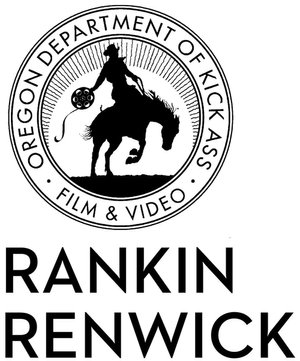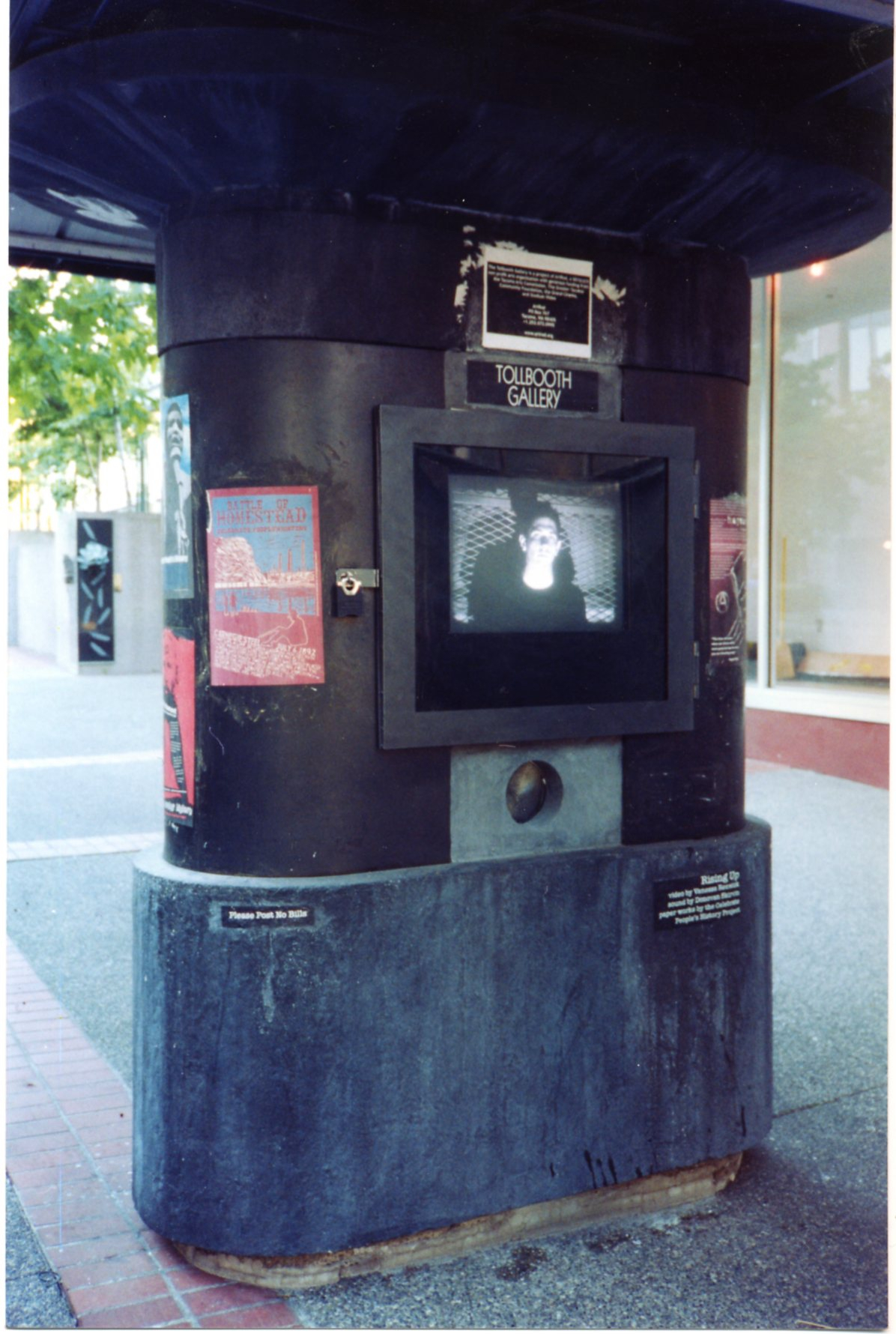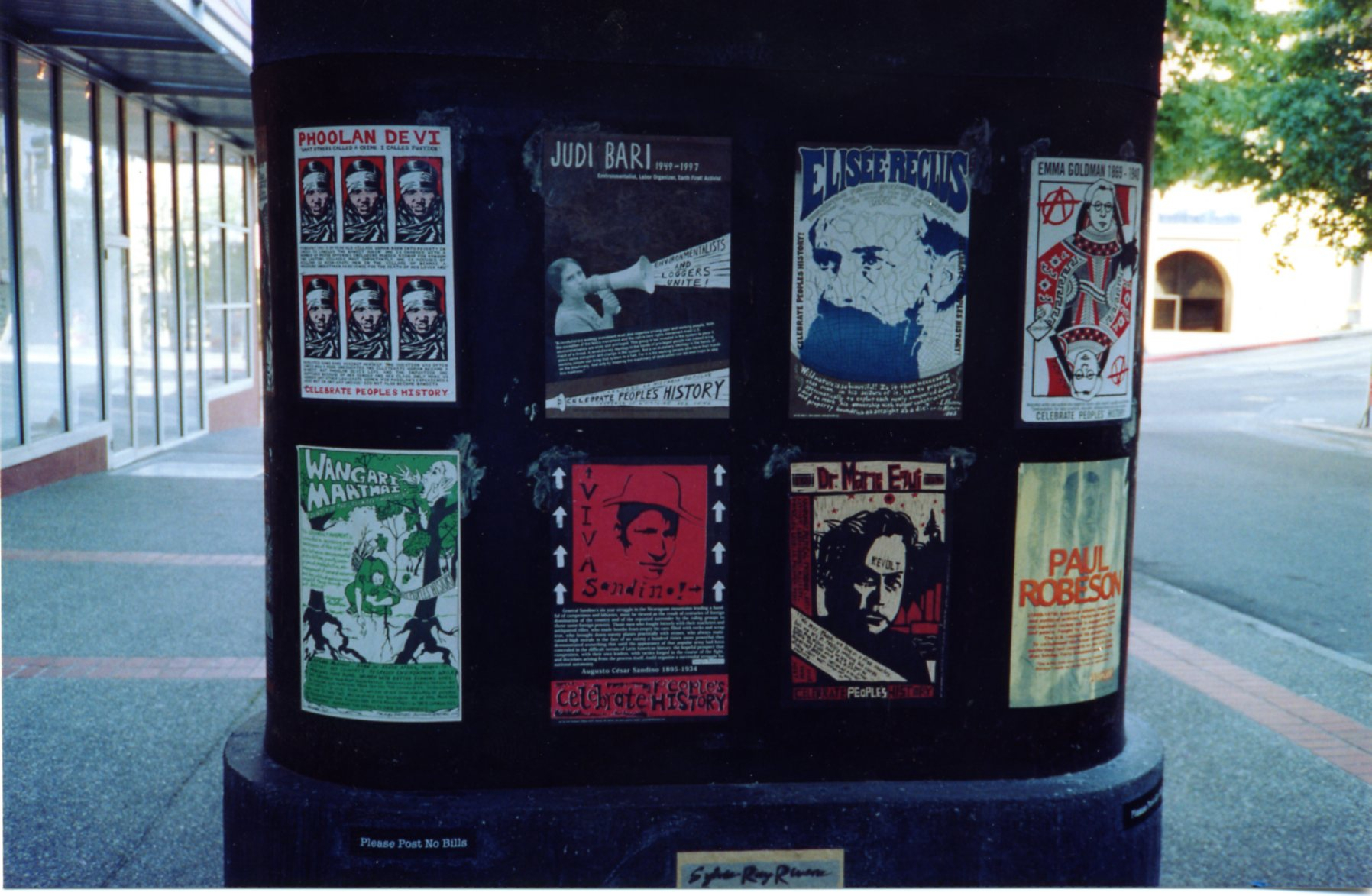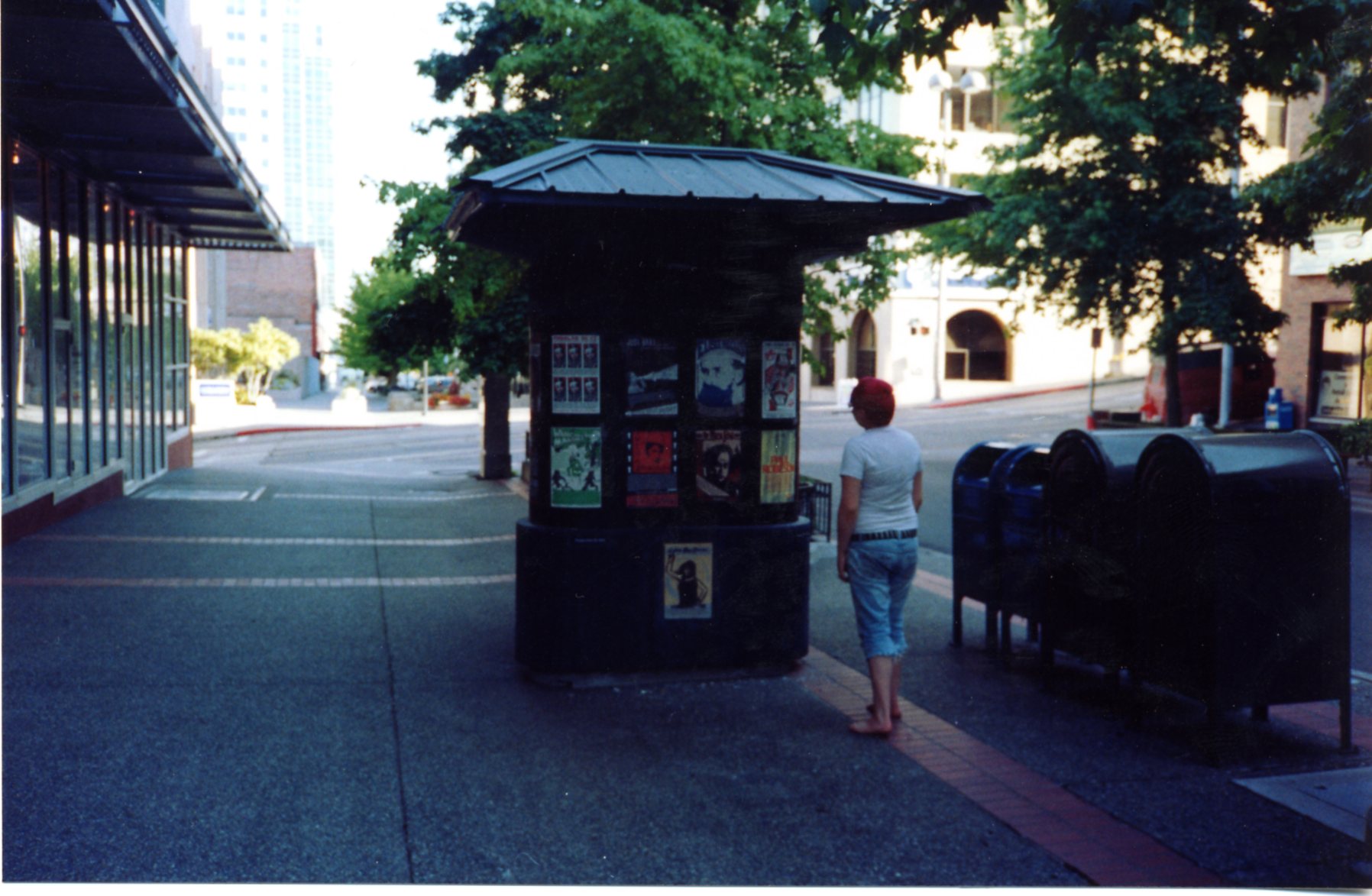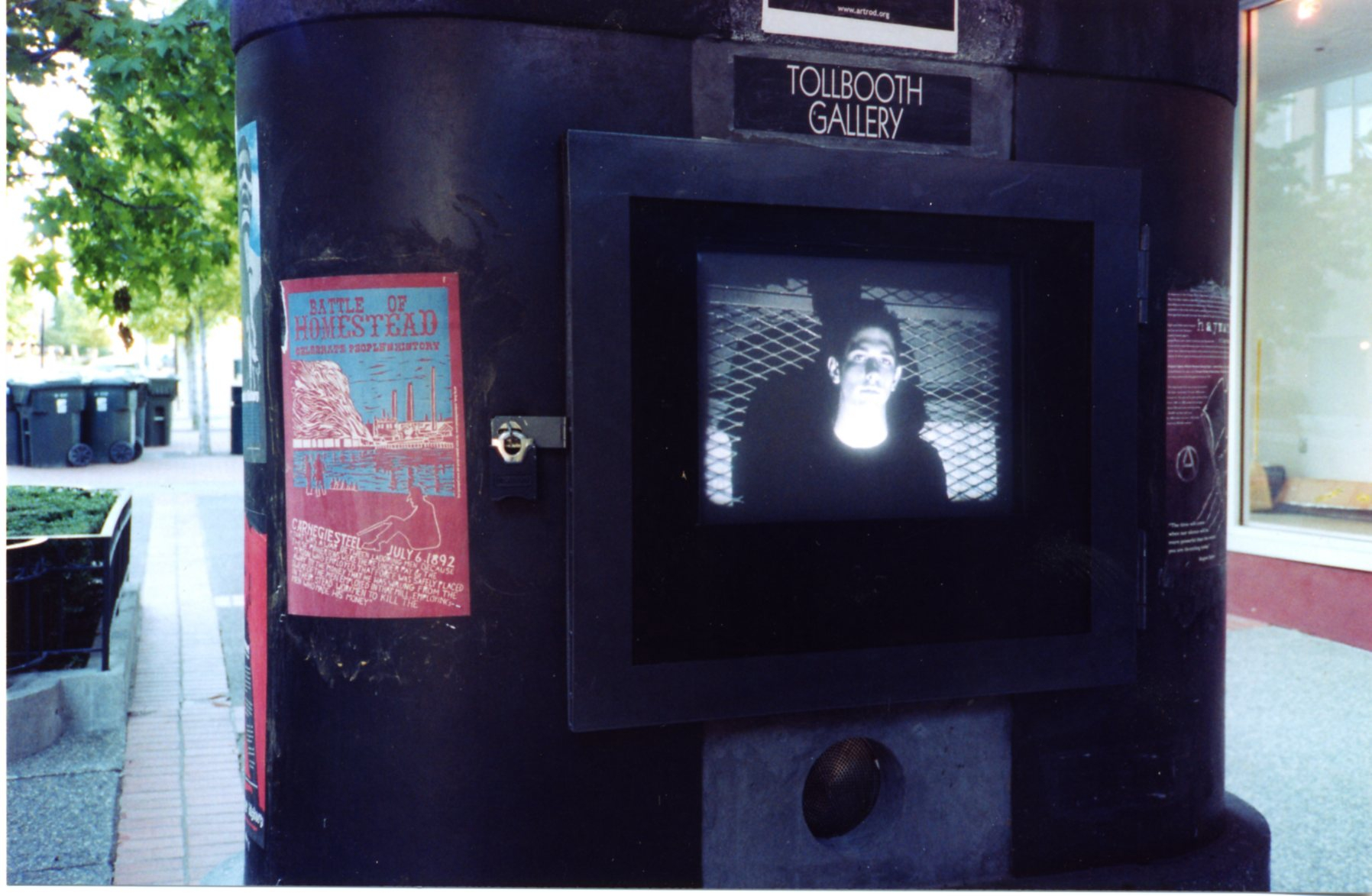Rising Up
2004, video installation, 16mm film loop to video and posters
synopsis:
A collaboration between The Oregon Department of Kick Ass, the Celebrate People’s History Poster Project and late audio artist Donovan Skirvin, at the outdoor Tollbooth Gallery, the ‘World’s Smallest Gallery Dedicated Exclusively to Experimental Video and Wheat-Pasted Paper Fine Arts’ in Tacoma, Wa. Rising Up features a bus shelter decorated with wheat-pasted posters that celebrate historical political victories of everyday people working alone or together to resist unjust oppressions under which they live and labor; the posters were arranged around a video monitor showing a loop of a man (Skirvin) descending in a freight elevator. The video piece is a comment on how awful it is to be a citizen of a country led by the Bush oligarchy, to be on a negative path descending into the bowels of human social existence; the art of the surrounding posters serves to remind the viewer to look outside the mainstream for inspiration, to seek out stories of victory and triumph, to look up, to rise up–figuratively and literally.
credits:
cinematography: Vanessa Renwick
score: Donovan Skirvin
posters: The Celebrate People's History Poster Project
interview:
Earlier this year, Portland based filmmaker and artist Vanessa Renwick collaborated with the Celebrate People's History Poster Project and audio artist Donovan Skirvin to create an installation entitled "Rising Up" at the Tollbooth Gallery, the World's Smallest Gallery Dedicated Exclusively to Experimental Video and Wheat-Pasted Paper Fine Arts in Tacoma, Wa.
Jared Pappas-Kelley: I am familiar with your work primarily through projects like the Lucky Bum Film Tour and Richart. Can you give me a little background on what these are and how they came about?
Vanessa Renwick: The Lucky Bum Film Tour was a film and video installation tour that Bill Daniel and I went on in 2002/2003 to seventy venues across the US and Canada. I was showing about 12 of my shorts, and Bill Daniel was showing a 2-projector video installation on hobo graff called "The Girl on the Train in The Moon". One of the movies I was showing was "Richart", which is a 23 minute documentary I made with a friend here in Portland, Dawn Smallman, about Richard Tracy, an artist who lives in Centralia, WA. I met Richart about 12 years ago, juts driving thru Centralia when I saw a house that was almost completely covered in sculpture. I stopped and got a 5-minute tour from Richart, as he called himself, and always made a point to visit him on trips north on I-5. I took a few workshops from him with my kids. The classes were in clay, Styrofoam, and collage. I always thought he would make an awesome documentary subject, as he is really inspiring to me, and when I met Dawn, who is really into outsider art, I asked if she wanted to make the flick with me. It has shown at the Andy Warhol Museum, the Smithsonian, all over the place.
JPK: There is a different dynamic as a viewer seeing work that the artist has taken on the road and is touring. How is it different as the artist presenting?
VR: Bill and I tend to stay away from festivals. Your work gets lost in a huge sea of films, and you do not have much chance to connect with your audience. When you hit the road with your work, your Q&A can go as long as people want it to. You have a chance to get some feedback on those works you have been toiling away on almost by yourself for so long. You make a lot of new friends along the way, and build up a network of venues for other makers to use. We try to show outside of traditional film venues as much as possible, galleries, museums, schools, punk rock basements, outside somewhere...
JPK: What draws you to this kind of work?
VR: Documentary in new forms is what really excites me. I consider myself an artist and an activist, and being a documentarian really allows me to do both in one fell swoop. Poetic justice.
JPK: What was your primary response when the Tollbooth approached you for an installation?
VR: I liked the idea of work outside where anyone can see it. That's a problem sometimes with video and film, the equipment is so expensive that it is hard to have things going 24 hours in public spaces outside.
JPK: What appeals to you about a project like the Tollbooth?
VR: I liked being able to collaborate with all the artists who have made posters for the Celebrate People's History Poster Project. I don't really do works on paper, and I thought that their work, which is made to be plastered up outside for all to see would be perfect for it. Also, that it is poster/flyer based, and kiosks are all about communicating with flyers.
JPK: Can you tell me a little about the People's History Project and Donovan Skirvin and how the collaboration for Rising Up came about?
VR: Donovan Skirvin has been doing sound for a lot of my films, videos, and installations since 98. I usually come up with the imagery, edit it, and then pass it on to Donovan with some suggestions of sound I want, or actual recordings of different sounds that I would like woven into the composition. With this piece, Donovan made the score pretty much on his own, I told him what my idea was for the video and posters going together, that this person in the video piece, going down in the freight elevator (who is Donovan), is in a sewer soup, going down, down, down in his life without any hope or initiative to do anything. A person who is drowning in the sewer soup of today's mess of the USA. It is so depressing to be living here in these times. To be a US citizen is a confusing thing. I saw an ad on the bus shelter in SF last week. A beautiful picture of New Zealand with the words" New Zealand: defectors welcome" I think that kind of sums up the torn feelings a lot of people are having being US citizens during the Bush reign. So, I thought it would be great to juxtapose this person going down in the freight elevator, who I think is a lot of us, with the posters from the celebrate people's history poster project, posters that celebrate heroes, people who got off their asses, out of the sewer soup, and did something radical to try a make the world a better place. Donovan has also done scores with Miranda July. I was aware of the Celebrate People's History Poster Project because some friends of mine, including my friend and favorite artist, Icky, had produced posters for the series. It is a project of the artist Josh MacPhee from Just Seeds. Here is what the project is about in his words:
"The series is an on-going project producing posters that focus around important moments in "people's history." These are events, groups, and individuals that we should celebrate because of their importance in the struggle for social justice and freedom, but are instead buried or erased by dominant history. Posters celebrate important acts of resistance, those who fought tirelessly for justice and truth, and the days on which we can claim victories for the forces of freedom. In the past 5 years over a dozen posters have been produced on a variety of subjects, from the Battle of Homestead to Fred Hampton, Malcolm X to Jane, an underground abortion collective. These posters have been and will continue to be posted publicly (i.e. wheat pasted on the street, put up in peoples home and storefront windows, and used in classrooms) in an attempt to help generate a discussion about our radical past, a discussion that is vital in preparing us to create a radical future. I have also been using this project to create a loose network of artists interested in creating radical public art and showcasing the work of unknown artists that want to create art that is functional, carries a social message, and doesn't get buried at the bottom of the heap of the capitalist "art world."
JPK: How do you think paper based work and video lend themselves to public art space?
VR: I am actually kind of leery of putting video out in public spaces. I think that images on monitors can be pretty invasive, T.V.'s in bars as an example. If I wanted to watch TV I would watch it in my house. I haven't watched TV in over 25 years, well, maybe a total of 3 hours of TV in those 25 years, where I was stuck in a snowstorm at my folks house, or at some motel, but I hate the medium the way it is now, and really hate being near TV's in public spaces because of what TV is. Paper is awesome. It is pretty damn cheap and one can slap it up anywhere. Artists Jessica Lynch of Slow Shirts has a great recipe for wheat paste. Someone whose paper work really excites me is Swoon. The Wooster Collective is a good place to see tons of communication going on in the public space. I just finished another public installation "Patriot Act" which had words out of neon tubing in glass library cases and paper copies of the U.S.A. Patriot Act for people to read. This was situated inside a library.
JPK: The work on display in a space like the Tollbooth seems fragile in that there really isn't much separating the work from the viewer. If somebody doesn't like part of the installation, the work could easily be altered, damaged, vandalized, or stolen at any time. How does that fit into how you approach the project?
VR: Well, I am pretty amazed people's work hasn't been messed with much yet, although I did just hear from you that the poster of Judy Bari just got ripped down by someone. Judi was a non-violent forest activist who was bombed, and then was absurdly charged by the FBI for carrying explosives. Who would want her poster down? An FBI agent strolling by? Work wheat pasted up outside is all about transformation of public space, open to the possibility of others coming along and collaborating or obliterating your piece.
JPK: How does this project fit into your past work?
VR: I like to present different sides of issues in a lot of my work and to make work that focuses on subjects full of hope and passion... there may be despair in there somewhere, but I really want to make work that moves one forward in some way.
JPK: What are you currently working on?
VR: I am making an installation for the PDX Contemporary Art Gallery window project in August. That piece is kind of another public art thing, since it is in a window facing the street. So far I have some ideas that are floating around, but nothing concrete for that yet. I have one goofy idea, which would probably sell, but feel like I should nix that and do something more relevant to the neighborhood it is in. the Pearl District is a horrible high-end consumer yuppie mono crop, I would really like to take advantage of having a window in that neighborhood to somehow comment on what I see happening to that part of town.
I have a new 3 projector, 23-minute installation piece, "Hope and Prey" that I will be taking on the road with Bill Daniel as part of the Heart Attack Island Film Tour in the NW this late August/Early Sept.
I have a video refrigeration installation that will be at the Sun Valley Center for the Arts in November.
The most important thing I am working on is "Critter", an experimental documentary essay on the wolf coming back into the West. I have been working on it for 5 1/2 years now, and want to shoot it on 16mm in B&W, so fundraising for Critter is what consumes a lot of my time. I am hopeful.
--from Toby Room Issue No. 10
